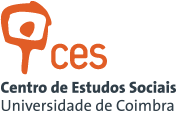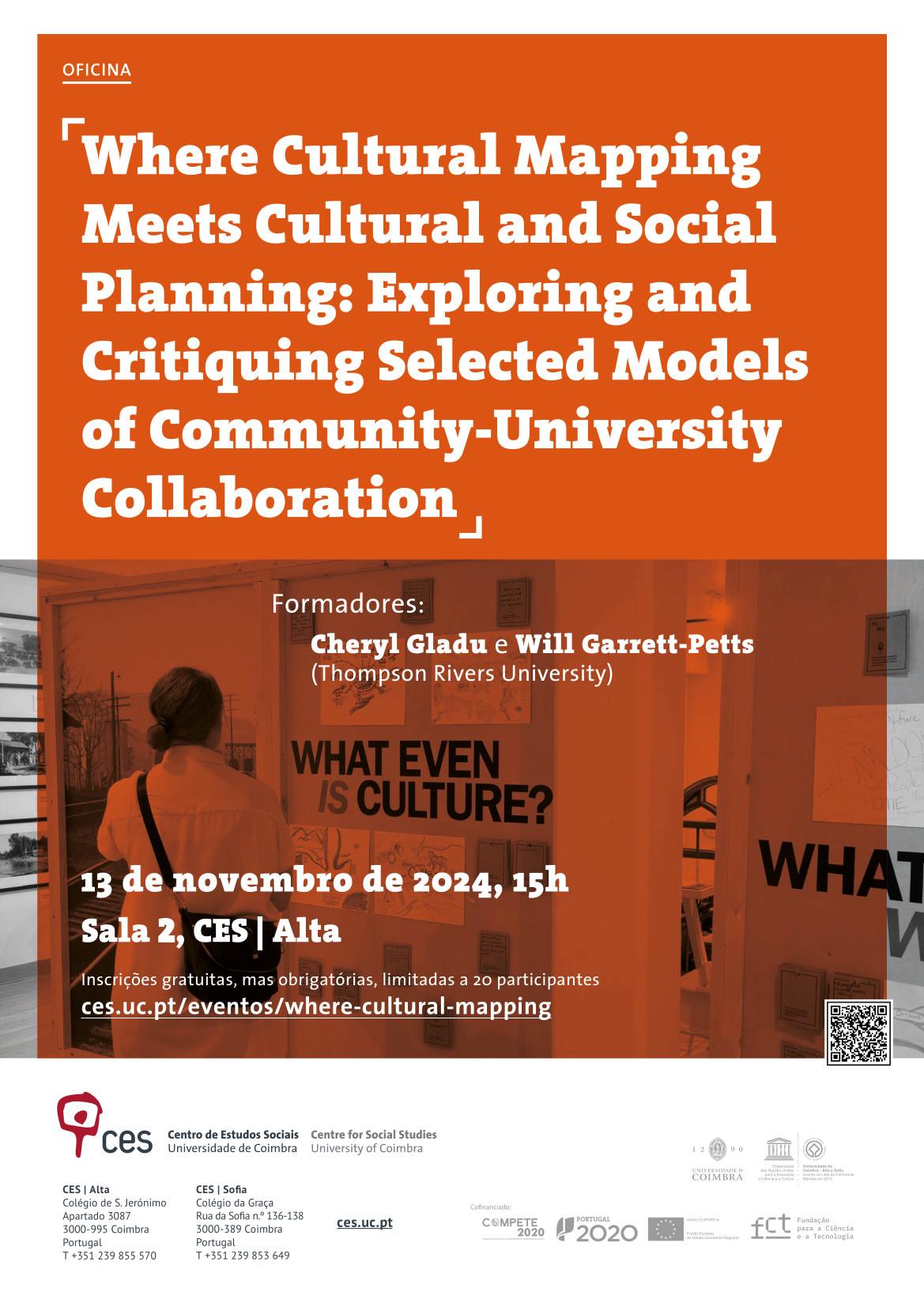Oficina
Where Cultural Mapping Meets Cultural and Social Planning: Exploring and Critiquing Selected Models of Community-University Collaboration
13 de novembro de 2024, 15h00
Sala 2, CES | Alta
Registration is free, but mandatory. Limited to 20 participants
____________________________________________________
This presentation and interactive workshop will explore how cultural mapping techniques can be adapted to effect change through collaborative partnerships with universities, local governments, the non-profit sector, the business sector, schools, and community organizations.
By the end of the master class workshop, participants will gain an enhanced understanding of how cultural maps are produced and interpreted; and in the process, they will explore how cultural mapping can enhance community-engaged research and can contribute to the development of long-term, sustainable partnerships.
Forms of participatory mapping, mental mapping, and journey mapping, such as those pioneered by Kevin Lynch (Image of the City, 1960) constitute an emerging field of cultural mapping practice that has become widely embedded in the governance structures of municipalities throughout the globe, enabling citizens, city planners, community organizers and key decision makers to view and assess ecologies of participation at play within their communities. Since the 1960s, and as a research methodology, cultural mapping has been refined to combine the tools of modern cartography with vernacular and participatory methods of storytelling—to represent spatially, visually, and textually the authentic knowledge and memories of local communities. In addition, a growing number of arts-based researchers, educators, and community developers have been working to explore place and community through bottom-up forms of “cultural mapping” rooted in creative expression and local knowledge (Duxbury, et al., 2019). Cultural maps—especially hand-drawn maps—assert that local inhabitants possess expert knowledge of their environments and can effectively represent a distinct understanding of their social, cultural and physical landscape that includes information excluded from mainstream or official maps.
In this presentation and interactive workshop, we will introduce participants to a brief history of cultural mapping (Duxbury and Garrett-Petts, 2023; Duxbury et al., 2019; Guildi, 2017) and show how techniques designed for mapping local cultures can effect social change via community-university partnerships. We will explore together how cultural mapping helps make visible the intangible dimensions of place, including the stories, emotions, rituals, sensations and relationships that inform and comprise the lived experience of those studying and working in schools. A key aspect of the workshop will include an opportunity for participants to work with and analyze the collection of community engagement maps developed as part of a five-year research program at TRU.
- Participants will distinguish between community-based, community-engaged, and community-driven research models
- Participants will gain an enhanced understanding of the history of cultural mapping
- Participants will distinguish between cultural mapping and “mapping culture”
- Participants with employ Kevin Lynch’s five elements of mental mapping—paths, edges, districts, nodes and landmarks—and practice a schema for analyzing and interpreting cultural maps
In addition, we will give particular attention to the various models of community-university collaboration:
- Participants will be asked to share their experiences, understandings and questions regarding city-university partnerships
- Participants will explore a number of case studies, including Researcher-in-Residence models
- Participants will co-develop key guidelines for establishing long-term partnerships
- Participants will look in-depth at the role of cultural mapping in moving partnerships beyond a project orientation to something long term and sustainable
By the end of the workshop, participants will gain an appreciation of how “expert” representations differ; and in the process, how inclusion of so-called “non expert” voices and viewpoints can contribute to—and possibly change—cultural and strategic planning in organizations, communities, cities and universities.
Each participant will receive a copy of The Cultural Mapping Workbook as an open educational resource.
Biographies of presenters
Will Garrett-Petts is Professor of English, Rhetoric and Canadian Studies, and Special Advisor on Integrated Strategic Planning at Thompson Rivers University. He serves as an elected At-Large Division Member with the Council on Undergraduate Research, as an Advisory Board Member for Arts in Society, as a Series Editor for the University of Calgary Press, and as a Collaborator Researcher with CES, University of Coimbra. His major publications include Artistic Approaches to Cultural Mapping (Routledge, 2019, 2021); Cultural Mapping as Cultural Inquiry (Routledge, 2015, 2021); Whose Culture is it, Anyway? Community Engagement in Small Cities (New Star Books, 2014); The Small Cities Book: On the Cultural Future of Small Cities (New Star Books, 2005); and PhotoGraphic Encounters: The Edges and Edginess of Reading Prose Pictures and Visual Fictions (University of Alberta Press, 2000). In 2023 he was awarded the Killam Visiting Professorship in Canadian Studies at Bridgewater State University.
Cheryl Gladu, Ph.D., Assistant Professor in the Department of Human Enterprise and Innovation at Thompson Rivers University, is an interdisciplinary scholar who studies, among other things, how people co-create and manage dynamic systems of governance in pursuit of solving problems, like neighbourhood development. In her post-doctoral position, she worked as the first Researcher-in-Residence at the City of Kamloops.
Selected References
Duxbury N., Garrett-Petts, W.F. and Longley, A. (2019). An introduction to the art of cultural mapping: Activating imaginaries and means of knowing. In: Duxbury N., Garrett-Petts, W.F. and Longley, A. (eds.), Artistic Approaches to Cultural Mapping: Activating Imaginaries and Means of Knowing. London: Routledge, pp.1–21.
Duxbury N., Garrett-Petts, W.F. and MacLennan, D. (eds.) (2015). Cultural Mapping as Cultural Inquiry. New York: Routledge.
Duxbury N., and Garrett-Petts, W.F. (2023). A Guide to Cultural Mapping. Thompson Rivers University. https://projectedi.trubox.ca/wp-content/uploads/sites/2249/2024/06/GuidetoCulturalMapping-Workbook-May23-NoCrops-copy-2.pdf
Garrett-Petts, W.F., and Gladu, C. “A Researcher-in-Residence Initiative for Cultural Mapping, Economic Development, Social Inclusion, and Urban Planning in Small Cities.” Livingmaps Review 11 (November 2021): 12 pp. https://www.livingmaps.org/wf-garrett-petts-and-cheryl-gladu
Guldi, J. (2017) A history of the participatory map. Public Culture 29(1): 79–112.
Lynch, K. (1960). The image of the City. MIT Press.


